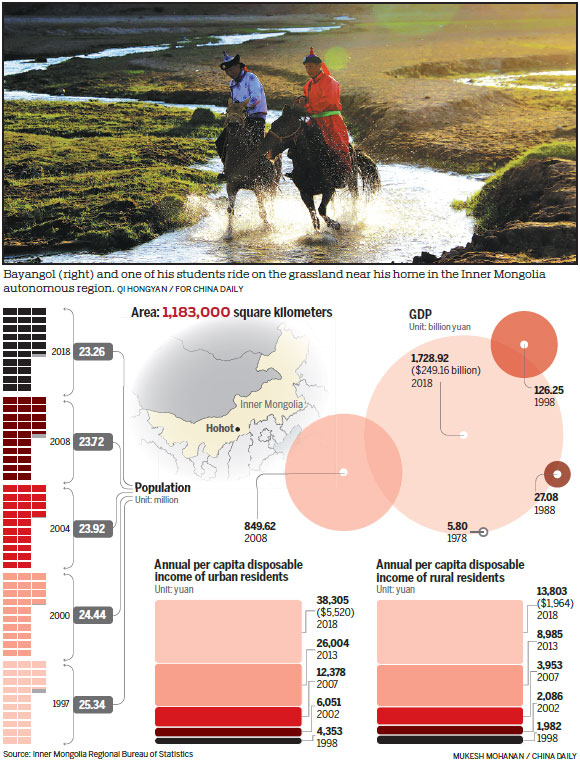Horsemen follow in steppes of Genghis Khan




Breeders and racers are keeping alive the culture and history of the golden line of equines used by the conquering Mongol
Editor's note: As the People's Republic of China prepares to celebrate its 70th anniversary on Oct 1, China Daily is featuring a series of stories on the role regions have played in the country's development and where they are today.
Moments before the flag waved to start the race, the atmosphere was tense. Dozens of horses and their riders milled around anxiously, jockeying for position at the starting line.
Riders in traditional Mongolian dress sized up their opponents as their mounts kicked up dust. You could hear the heavy breathing of the horses as they stepped nervously in high spirits. They wanted to run, as their nomadic ancestors had since before Genghis Khan, the great Mongol ruler. The riders maintained tight control of the reins to keep the animals behind the line.
Some of the horses shimmered like gold as they maneuvered, reflecting the color of the vast plains of the Inner Mongolia autonomous region at sunset. They are the breed said to have been used by the ancient warlord himself. The very air seemed supercharged as the big moment approached. Then, at last, the flag fluttered and the horses surged ahead, as if released by a steel spring. Riders leaned forward to stay in their saddles.
For Urjin, a 36-year-old herdsman, the moment was electric. "I could feel the power of my horse in every movement," he said. "And I was as excited as he was."
The horse race, held on July 14 in a grazing district of Bayannur, a prefecture-level city in the region's southwest, attracted more than 100 riders and 600 spectators. Riders ranged in age from 12 to 60. The crowd stood for a better view as the horses took off. Some shouted encouraging words.
Urjin had a good start on his golden mount, finding himself in fifth or sixth place as the pack of horses thundered away in a cloud of dust. He concentrated intently as other riders tried to overtake him. His own horse began closing the distance to the leaders as he rounded the flag marking the far end of the course 1,000 meters from the start. To complete the race, riders would make four 2,000-meter circuits - each one the same length as the Kentucky Derby in the United States.
The grueling 8,000 meters was a testament to the endurance and strength of the Mongolian horses and the riders who have mastered them for 20 centuries.
By the end of the second circuit, Urjin had begun to catch up to the leaders. For others, the blistering pace was too much. A few horses dropped out and some riders dismounted. Urjin stormed ahead, continuing to gain ground through the third and fourth circuits, and finishing the race in second place.
His friend and riding coach, Bayangol - who had given him the golden horse as a gift - came out to greet him with smiles and cheers as Urjin brought the animal to a canter to calm and cool it.
Master of horses
Bayangol, 43, a horse racer and breeder, organized the competition, just as he has done many times over the years. His whole life in Inner Mongolia has been linked closely with horses. They're a family tradition. He raises the same golden breed that propelled Genghis Khan to fame.
Bayangol spoke approvingly of Urjin's performance.
"I gave him this horse because I could read the affection in his eyes," Bayangol said. "He performed well in the race. He is excellent."
Bayangol, who also raises sheep, swore 20 years ago that he would never raise horses. It took too great a toll on his emotions the first time he was forced to sell the animals to pay for his brother's cancer treatments.
Physically tough though he is, tears filled his eyes as he remembered. "I'm the fourth kid in my family, and we were poor. My brother got cancer when he was only 29, so the family decided to sell off the horses for 800 yuan each," Bayangol said. "I clearly remember getting on a mare and leading others to the buyer's trailer.
"I gently pulled out some of the mane of my favorite horse and tied the hair around my wrist as a memento. I was so sad and said to myself that I would never raise horses again because I cannot bear the separation."
Yet he has many good memories as well. Raising horses as a child with his family shaped him as an adult.
He broke his vow briefly in 1997 when he picked up two ponies at a time the region was experiencing a severe drought. The animals' mothers had died and they needed help.
"I used a nursing bottle to feed them and borrowed stallions to mate with them when they were mature. We had a strong emotional connection. I never needed to use a bridle or saddle to ride them. Selling them broke my heart."
Bayangol didn't touch horses for 10 years after that. But then he married Sarnaa, who has become his cherished partner. His new father-in-law gave him a white-spotted yellow horse, the most exalted breed in Inner Mongolian tradition - the war horse of Genghis Khan.
"If someone can raise these horses well, he will have good luck and secure his fortune," Bayangol said. "I was pretty nervous at first and turned to older generations of experienced breeders to learn what I needed to know about feeding. I got baby white-spotted yellow horses every year, which I considered great luck."
Now, Bayangol has more than 70 of the animals.
Qin Yu, head of the local association dedicated to the white-spotted yellow horses - and which sponsored the race - said there are about 200 members, including Bayangol. "We founded the association recently to protect the breed and develop tourism around the horses," he said. The group plans to sponsor more races and develop creative, culturally based products in the future.
Extraordinary animals
Bayangol's father was of Han ethnicity, and his mother was from the Mongolian ethnic group. Both came from families of herdsmen who had long depended on horses for transportation.
The climate and weather in the region is harsh, with winds and dust in the spring. There's typically no precipitation during 90 percent of the days each year. Winters can be bitingly cold, with lows reaching-30 C. Scant relief comes in the rainy season, from July to October.
"The harsh weather has made the local horses different from other types in other places in the world," Bayangol said. "Our horses are accustomed to tough living conditions. At the same time, because they are affected by the natural environment, their character is wild and they are hard to tame."
Foreign-bred horses in the area may run faster than local horses for a short distance, he noted, but they lack stamina. They are also dependent on humans. They must be fed manually, rather than living on the scraggly grass of the open range.
"Once an ordinary foreign horse is tamed, it will always be docile. But a tame Mongolian horse will only allow its owner to get close. Even after taming, it will become wild again if you don't ride it enough," Bayangol said.
In addition, Mongolian horses are strong-willed, with great perseverance. "As long as they can run - and even if they're injured - they'll run until their guts fall out," Bayangol said. "They will keep running to the last breath. That's a precious characteristic that other animals, such as sheep, cows and camels, don't possess."
Moreover, he said, "Mongolian horses are loyal to their owners. No matter how far they are taken away, if they can find a way to escape they'll run back home. I was absent for half a year, and when my horses saw me coming home, they whinnied to express the feeling of missing me. It was very touching."
Economic factors
As the economy of Inner Mongolia has developed, the role of horses has waned. They are no longer tools for transportation. They've been replaced by cars, motorcycles and trucks.
Raising horses has become increasingly commercial - either for sale or for racing. The average price of a horse is around 7,000 yuan ($992), and the market has been growing rapidly.
Herdsmen often sell their horses to a dealer, and the dealer resells them to meat markets or horse clubs.
Many horse-related products, such as mare's milk, horse oil and horse hair from the mane, have gained popularity in recent years, which in turn provides business opportunities.
Bayangol never sells horses as meat. "My horses have brought me many honors through racing," he said. "I would never treat them that way. Unfortunately, I can only keep a certain number of them on the meadows I own. The land must be protected from overgrazing, so I have to sell sometimes."
On average, Bayangol sells about 30 horses a year, which can bring him income of about 90,000 yuan.
"Compared with 10 years ago, the price of horses is much higher as a result of growing interest from the public in horse culture and riding. But I still feel pretty down every time I sell one," he said.
Meanwhile, conditions on the land have improved. Sarnaa, Bayangol's wife of 20 years, noted how the government stepped in to provide a steady supply of water on the barren plains. "In the past, our meadows received only occasional rain. There was no reliable water source," she said. "Last year, the central government helped us drill a 120-meter-deep well, which has brought precious water to the land."
Cultural guardian
Horse racing is deeply embedded in the hearts of the descendants of Inner Mongolia's nomads. There is no substitute.
"I get very excited when I race," said Bayangol, who never wears protective gear, preferring to ride in the traditional Mongolian way. He placed third last year in a regional competition. And he remains firmly focused on preserving his heritage.
As people's living conditions improve, their passion for horse racing grows, especially among the younger generation, Bayangol said. But it's becoming more difficult to find good horsemen. Many young people leave their rural roots behind, seeing city life as a gateway to a different, more modern life with a higher living standard.
Bayangol has tried to find ways to keep interest alive and growing.
"We often hold local races aimed at gathering people to enjoy the horse culture," he said. "Some sheep herdsmen participate in every race, and they don't care much about the results. They just love riding and racing and immersing themselves in the tradition that goes with it."
He feels it's his responsibility to pass the horse culture to the next generation and to ensure that the golden Mongolian horses are protected.
"Those horses have brought me great joy, as well as wealth. So I have deep gratitude and love for them. Anytime I feel pressured, I go to the stable or the pasture for a while to sit beside the horses. They heal me."
The lessons he has learned from the endurance and perseverance of the Mongolian horses encourages him in many aspects of life, he said.
Sarnaa supports his love of the animals and career. She has been a valuable partner, helping him raise the horses and sheep every day and taking care of daily family matters. The culture runs equally deep for her, as it does for Amjilt, their 19-year-old son, who has tasted the extremes of physical endurance, like the horses, in his pursuit of Greco-Roman wrestling.
He said it is sometimes hard for him to understand his father's love of horses.
"My family has had horses around since I was born. I have a feeling that my dad can only stand two days at most not touching his horses," Amjilt said.
"He and horses have a unbreakable link and emotion. I think only true love can describe it."
Contact the writers at dujuan@chinadaily.com.cn


(China Daily Global 08/07/2019 page5)














